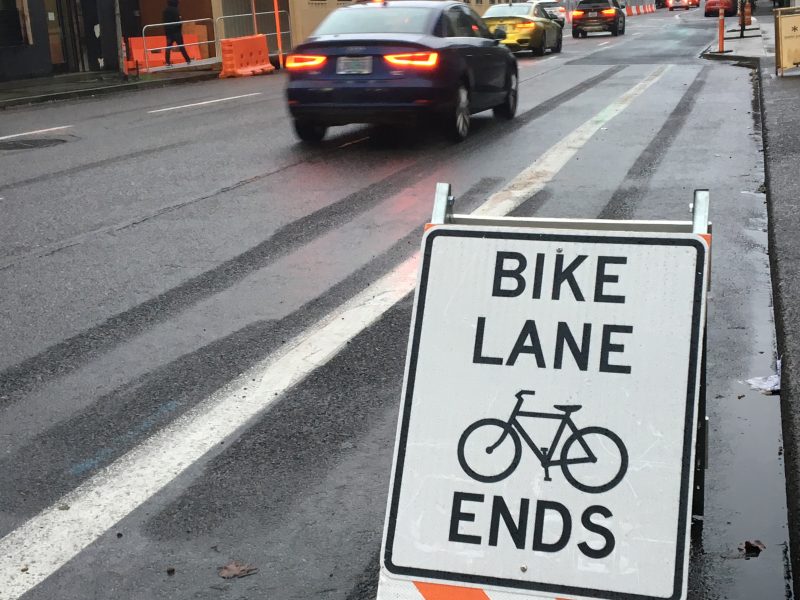
(Photos: J. Maus/BikePortland)
The Little Things is a new column where we share (relatively) small problems — and little miracles — in our street network. Is there a little thing that makes your ride uncomfortable, annoying, inspiring, or exhilirating? Tell us about it and we’ll consider it for a future column.
The thing
A north-south connector that straddles I-405, NW 14th Avenue is one of those streets that should be much better for bicycling than it is. It’s a useful piece of the bike network that can get you across town all the way from SW Jefferson to NW Quimby. When the Flanders Crossing Bridge opens, 14th will be even more important. Unfortunately the bikeway design is sub-par. Auto users dominate the streetscape and there are several sections that are way too stressful.
We’ll never forget when, on October 11th, 2007, young Tracey Sparling was killed by a truck driver at 14th and Burnside. Then there’s the dangerous right-hook risk at 14th and Everett a few blocks away (thankfully PBOT has installed some plastic wands to defend the bike lane), the big trucks delivering to Safeway that block the bike lane just north of Lovejoy, and so on.
And now this: A new development on 14th just before Glisan (Google Map), has extended the sidewalk directly into the bike lane. PBOT took no proactive measures to keep the bike lane safe and continuous, so bicycle riders are abruptly forced into a shared-lane situation on a high volume street.
Advertisement
What you told us about it
➤ On January 12th we heard from reader T. Clark via email: “I was nearly hit by a car while trying to get over because there are no warning or yellow paint, just a bike lane that ends in curb before picking up again past the building.”
➤ On January 21st we heard from @maccoinnich on Twitter that, “This creates a really dangerous situation… it made me pretty scared even as ‘strong and fearless’ cyclist.”
➤ On January 23rd we heard from @RchyRsh on Twitter that, “I emailed @PBOTinfo about this when it was a #workzonewtf that abruptly forced people riding bikes from a bike lane into oncoming car traffic. They acknowledged this was a problem then and still allowed this project.”
The official response
I asked PBOT Communications Director John Brady to explain how this happened. Here’s his response:
“Two things are going on here. One, on the eastside of 14th, the developer put in a sidewalk improvement that extended the sidewalk from a substandard 8 feet to 12 feet. On the westside, the construction project has installed, in line with our guidance about ensuring safe pedestrian access, a protected pedestrian walkway. These two things have narrowed the roadway, and we need to install some temporary striping to fit the new road conditions. This will happen soon and it will include an improvement to the bike lane. It will be a buffered bike lane.”
I asked Brady why PBOT wasn’t proactive in making sure there was no service gap in the bike lane. I’ll update this when I hear back.
Wrapping it up
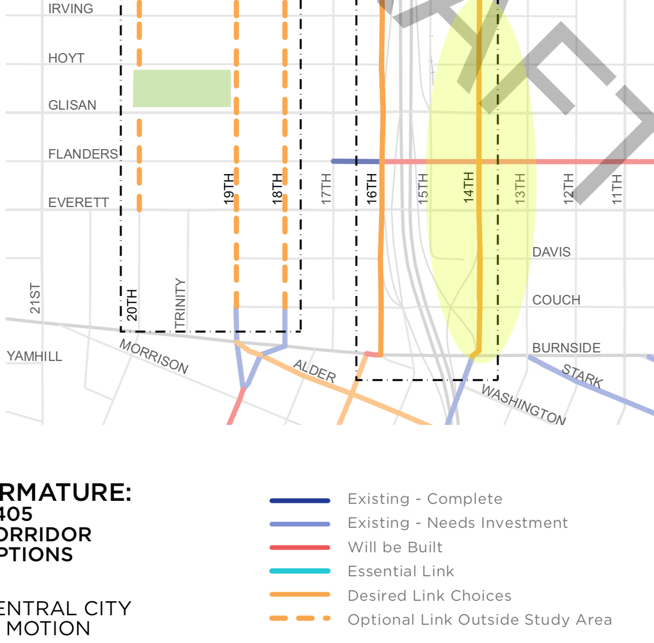
It’s great to hear that PBOT should have a fix soon — but this type of thing should never happen. Disruptions and closures to bike-only lanes should be taken just as — if not more — seriously than disruptions to other lanes. While we’re waiting for PBOT to stripe a buffered bike lane here, keep in mind that the City has even larger plans for the bikeway on 14th. Their Central City in Motion project maps released last month show 14th as a “Desired link choice” in the upcoming protected bikeway network.
We need your help to keep this column going. If you’d like to contribute, take some notes and a few photos and send them to us!
— Jonathan Maus: (503) 706-8804, @jonathan_maus on Twitter and jonathan@bikeportland.org
Never miss a story. Sign-up for the daily BP Headlines email.
BikePortland needs your support.


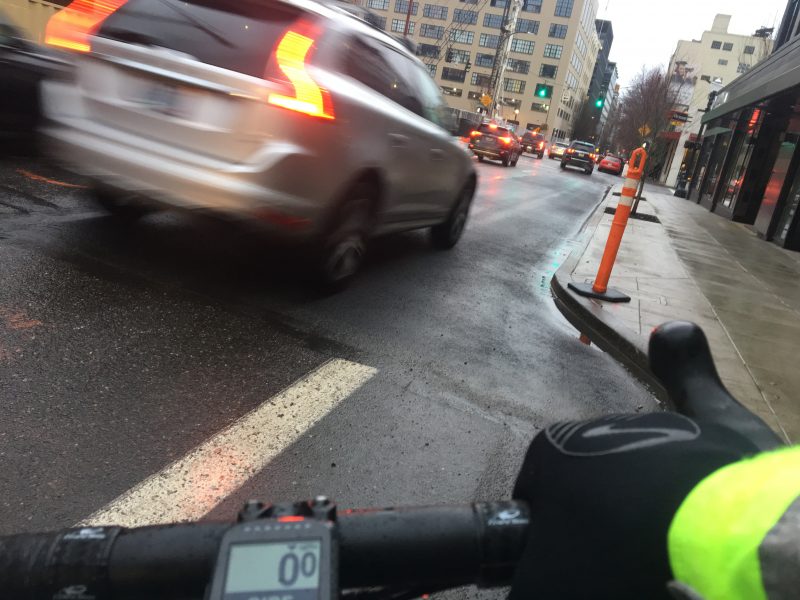
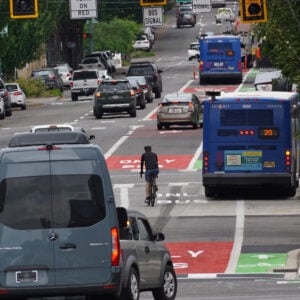
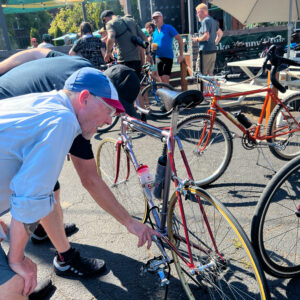
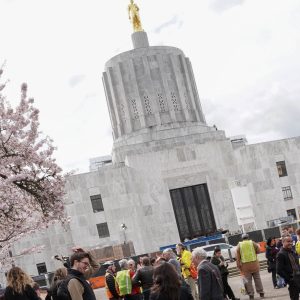
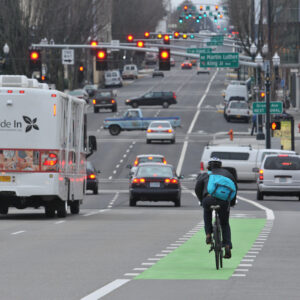
Thanks for reading.
BikePortland has served this community with independent community journalism since 2005. We rely on subscriptions from readers like you to survive. Your financial support is vital in keeping this valuable resource alive and well.
Please subscribe today to strengthen and expand our work.
Why not have a protected pedestrian walkway, one lane of car traffic (instead of 2), and a protected bike line during construction?
It’s actually 3 lanes of car traffic at the point in the photo.
“Disruptions and closures to bike-only lanes should be taken just as — if not more — seriously than disruptions to other lanes.”
This right here says it all. Riding every day through the maze that is our bike network it is clear that bicycle access is the lowest priority, in a fierce competition with pedestrians, especially when construction is involved. Closing bike lanes seems to be mandatory for most construction projects though creating any kind of appropriate detour is optional.
I would be happy to provide as many locations that would be appropriate for this series as you would like. The 19+ miles on the daily route has seemingly countless “Little Things” both good and bad.
First Rule of Pearl District, convenience of expensive condo owners and developers must always come before the safety of the plebs who are consigned to non-motorized transport.
That’s a pretty unfair characterization.
You are right, the first rule applies nearly everywhere in America, not just the Pearl District.
considering how awful the pearl’s bike infrastructure is, i think the statement is fair.
I agree that the Pearl has woefully inadequate bike infrastructure, but the way I read it was OP was making an unjustified dig at the people who live in that neighborhood.
Hopefully Central City In Motion will bring huge upgrades to the Pearl’s bike infrastructure, which really lags what other neighborhoods have.
I think an important but under-considered distinction here is that owners =/= residents.
What is a pleb?
In ancient Rome, the plebs were the general body of free Roman citizens who were not patricians, as determined by the census. From the 4th century BC or earlier, they were known as commoners (part of the lower social status).
Short for plebian, a commoner.
Not really true.
I thought First Rule of Pearl District was that you do not talk about the Pearl District.
Not everyone in the Pearl owns their place.
According to the 2010 census 64.4% of the housing units in the Pearl were renter occupied. Given that most of the construction since then has been apartments (not condos) that figure is probably higher now.
If I had a nickel every time someone at PBOT told me that a “fix is coming” or there is a planned project to address this issue on the books, I could buy a new bike tube.
What they don’t tell you is that “fix” will get subjected to endless delayed implementation. Now coming to a bike lane near you in 2022 (which will be delayed 5 more times to 2029).
It is the little things.
There’s been a “little thing” here for a while. Just North of Glisan, two full-width travel lanes merge into one at the point where an offset in the right-hand curb line pushes the bike lane to the left, so if a car travels straight across the intersection it will actually be in the bike lane. It’s a place where you are either actively managing the car drivers on your left or else trusting the paint to keep you safe.
All of the problems with paint bike stripe bike lanes show up in this area. First, the bike lane isn’t really necessary–the grade of the street is down hill transitioning to flat as you go North, and multiple stop lights and stop signs reduce car speed almost down to the speed of an average cyclist. There are many streets where drivers want to turn right across the bike lane so every crossing has a right hook hazard. There’s curbside parking on the right hand side of the street. The bike lane is frequently interrupted by construction in the area. The pavement is often cut up in the bike lane, temporary repairs are uneven at best, and the paint stripes are not always promptly restored.
Paint stripe bike lanes aren’t a serious solution to increasing bike mobility. They look good on paper, it’s a quick way to run up statistics, but they don’t wear well. The apparent refuge of a bike lane on NW 14th is a false promise that makes as many problems as it solves.
“actively managing the car drivers on your left” is so very 8-80
lousy planning
“The little things.” Indeed, making one’s way on a bike, transit and foot is composed of thousands of little things. Some of them are incredibly awesome like friendly smiles, nods, waves and greetings and seeing a neighbor five miles from home riding the other way. However, a few of these little things are truly life-threatening.
It is my belief that the awful “little things” wouldn’t happen if city, county and state employees were required to ride bikes to and from work at least weekly. It’s their windshield perspective that allows them to see the people endangered by the sort of little thing highlighted here as some annoying “other” rather than as a human being who is being needlessly placed in harm’s way. We have a serious empathy deficit.
If you look at where bikes are parked downtown, you might fairly decide that city employees do tend to ride bikes at a rate much above that of other downtown workers. I’d like to see the city proactively hire longterm bike commuters to plan streets. Maybe they already do that? I do know that several PBOT employees ride every day.
City employees are only part of the culture that shapes streets. Developers, architects, engineers, construction managers and builders–I think that a lot of these people wonder why city employees have such a love affair with bikes.
I was a member of the Mayor’s Bicycle Committee in another community. One of our committee rules was that we made our committee recommendations at on-site meetings. That way we actually saw what the conditions were or could be.
I agree that far too few staffers and decision makers actually pay any attention to what they are proposing, changing, planning because they have no experience doing.
There are so many of these little things that I wonder if a more targeted approach would be more productive.
Large cracks and holes in busy areas — particularly in crowded areas where you need to carry some speed — represent a serious safety issue (particularly in dark and wet) that are harder to mitigate than vehicles.
6th and Jackson strikes me an area that affects many cyclists who lose the bike lane while cars merge from the right and pass on the left while they ride over metal and dodgy pavement while needing to watch for peds in the dark.
I’m not holding my breath for a fix. How long did it take to fill in that large hole on Interstate and Russel despite being a very busy bike route…
How is the same bureau of transportation that proposed a world class PHYSICALLY protected bike project on Naito a few weeks ago the same one that is handling this situation. Why is PBOT afraid of being bold? I’ve never seen a place with more bike culture that had such dangerous bike infrastructure. The bicycle mode share will continue to drop until PBOT gets serious about physically protected lanes not just on Naito, but places like NW 14th.
It appears that the bike advocacy community was a bit asleep when the City approved this wider sidewalk. I would not be surprised if the City advocated for the widening in the first place.
Right, free rent for a sidewalk cafe’s roped off tables in the public right of way, no doubt.
Exactumundo.
Sounds like a nice amenity to downtown – very European.
correction- a sidewalk cafe pays the City of Portland annually, a permit fee, to place tables, chairs, and/or a-frame signs on the citys sidewalks. although anyone can camp for free in the public right of way as long as they allow 4 feet of safe travel on sidewalk. But normally businesses pay to put seating on the sidewalk.
The wider sidewalk was almost certainly reviewed as part of the public works permit associated with the renovation of the adjacent building. There’s no citizen involvement component to the public works process, so I’m not sure what if anything the bike advocacy community could have done.
You’re right. The failure was on the part of the staffer assigned to the project who was looking only at the specifics without giving any thought to conflicting plans and policies. And, he/she failed to consult others who could offer advice/perspective.
“who was looking only at the specifics without giving any thought to conflicting plans and policies.”
this.
I’m amazed how frequently this seems to be the MO around here. You’d think that in a city bureau it would be exactly this kind of (missing) perspicacity that would be rewarded, but no.
The widened sidewalk is part of the adopted right-of-way standard street plan for the Pearl District. It’s been on the books for years, just waiting for development to occur. The issue in this case is that there happens to be a development on the other side of 14th as well, and someone dropped the ball as far as providing a temporary re-striping that works for bikes. Once that other development is done, there will be room for the bike lane and two travel lanes.
Yet another reason to remove all motorized traffic from NW 13th.
Right. When we start to see car-free streets as an attractor rather than a deficit these “little things” will begin to go away.
It’ll happen. In our lifetimes.
The future will be human powered.
“put in a sidewalk improvement that extended the sidewalk from a substandard 8 feet to 12 feet” -PBOT
Seems like they are prioritizing aesthetics over safety and usability. You still can only walk using a “substandard” 8 foot of sidewalk because of the decorative trees blocking travel on the added (and “improved”) 4 feet.
The furnishing zone is not purely “aesthetic.” It acts as an important buffer between pedestrians and moving traffic (including bikes), provides space for bike racks, benches, fountains, etc, and also trees are a good thing to have. A sidewalk without a furnishing zone is definitely sub-standard. The problem here is with the striping, not the sidewalk.
The funny thing is, the bike lane they removed already provided peds with a buffer from traffic. (unless you’re implying that walkers need a buffer from bikes, which doesn’t appear to be a design standard in most other places, like MUPs)
I ride this stretch everyday. Just a few blocks further north, at Johnson, there’s a crosswalk that only extends partway across the street now, due to some recent street repair.
Whatever happened to leaving things better than how you found it?
There’s two issues – the removal of the bike lane for 200 feet, and the dangerous manner in which the changes occurred with no signage.
I almost got hit here as well because it’s difficult to see the new unpainted/unsigned curb extension that suddenly blocks the bike lane and forces one to stop, or jump the curb, or veer into the next lane.
How is a fix coming? The bike lane now ends for 200 feet and then starts up again. Are they removing the new sidewalk? Adding a ramp on either end of the extension that will serve as the bike lane? The response from PBOT is unclear.
Couldn’t the bike lane stay if one vehicle lane or parking lane is temporarily removed? Google street view shows plenty of room for the bike lane to exist. Over and over, bike infrastructure is the first to go when road space is in contest, but the problem is not a lack of space; it is a lack of intention to prioritize bicycling in America’s bicycle capital.
There’s no parking on that block of NW 14th, but it does have three travel lanes–which seems unnecessary given that it transitions to one travel lane north of Glisan. A left turn lane and through lane should be sufficient for motorized traffic, leaving room for a generous bike lane.
I see more evidence of provision for pedestrians and bike riders in construction areas as time goes on. Sometimes the bike lane blockage is neither planned or permitted. There’s a vicious cycle operating here. Because bike lanes are not evidently in constant use they are seen as the first place to set up a sign, or park a truck, or drop a dumpster. Because bike lanes may be obstructed they aren’t always attractive places to ride, especially for beginning cyclists.
It seems that construction workers need 200 pounds of tools to practice their trade these days so that equals truck. Like cops, construction workers drive as part of their trade so even the occasional hippy/radical carpenter has a truck. There’s not much overlap and sometimes not much sympathy between builders and bicyclists. It takes a certain amount of grace to approach people on the scene where something is blocking your way and sort it out. I’m not always personally in that state.
The last thing I called in to 823-SAFE hasn’t been fixed yet (the sunken pavement from a utility cut in the righthand lane of SW 2nd between Madison and Main, a nasty bit of work that could crash the unwary even with wide tires) but I’ll keep trying.
The explanation from PBOT Communications Director John Brady is really NOT an answer to what happened to the bike lane. The protected pedestrian walkway on the other side does not really factor into this equation at all. It’s a distraction that is intended to focus our attention away from what they got wrong (bike lane), to something they did right (protected walkway). The simple fact is that the bike lane was built over with NO planning and foresight by PBOT. The walkway offers no credible excuse.
When the protected walkway was put in the striping was moved west, which can be seen in the first photo. When that traffic control plan was approved the person who reviewed that was likely unaware of the planned widening of the sidewalk on the east side of the street (to the same width as the block faces to the north and south). My guess is that no one realized the combined effect of these two separate projects would be to remove the bike lane, i.e. PBOT messed up here through a lack of internal coordination rather than through any kind of bad intent.
Correct. Permit jobs are reviewed independently, often by separate staff, and I can see how this got missed. Unfortunate, but these things happen.
Exactly.
Thanks!
Doesn’t explain why the new curb extension was unveiled in a sudden manner with no signage. It blocks the entire bike lane. Even the private contractor should have been aware this was a problem (and a liability for them when someone gets hurt).
It looks like the bike lane was floating, and was moved to be next to the curb for the construction. But then the sidewalk expansion took over the bike lane. Look at the two darkened black lines. If the bike lane moves back to that, it will be fine
One more thing: NW 14th street is not part of the Twenty is Plenty speed reductions. Motorist really come flying down this road, at speed, as they exit 405. Just another part of the problem.
There’s easily over a thousand people who live directly on that stretch of NW 14th Ave, but it’s not classified as “residential” street.
Hopefully the light that will be added at 14th & Flanders, as part of the bridge / greenway project, will help slow down traffic.
2 of my long term pet peeves :
1 – the disappearing bike lane on SW Stark between 1st and Naito, its ok when traffic is light but sometimes during rush hour one cannot even take the lane cause drivers on either side will not let you in. Many folks opt to go right down the middle but its uncomfortable and feels unsafe (to me).
2 – the worn off (green) paint and bike stencils at the beginning of SW stark between SW 12th and 10th. This means I often have to take the car lane because some clueless driver is in the bike lane. My many requests to PDOT over several years have been ignored, they cannot even bother to maintain the piddly infrastructure that’s already in place. none of this will stop me riding, but for many newbies I’m sure stuff like this is discouraging to the point of not even trying again.
If it were left to me I would kill the SW Stark bike lane entirely. It’s downhill, bike riders can pick the lane they want, move at the same speed as the cars, and not get hooked because car drivers don’t (usually) turn across lanes that aren’t bike lanes. They are a bit less likely to unload in the lane if it’s not a bike lane.
Haven’t ridden it, but from Google maps it looks like a good road for sharrows.
14th north of Burnside just reeks of right-hook potential — way too many fast drivers who need to suddenly turn right without warning. I changed up my commute to get off it.
Jonathan – when I saw the new column “The Little Things”…I was expecting a series on the little “good” things being done…sadly I was wrong.
“The Little Things is a new column where we share (relatively) small problems — and little miracles — in our street network.” – his first sentence
I want to share the good things too! (I am really trying to be more positive this year).
I think good things should be shared too, but I think there is good in things like this which corral the community around small, doable fixes that promote incalculable safety and well-being. I feel positive and grateful when we do this as much as when we appreciate what has already been done.
Simply removing the rightmost auto lane and striping a buffered bike lane may not be enough. On a rainy night, it can be difficult to see painted stripes, and drivers may be distracted by trying to merge from two lanes to one. Perhaps some wands to delineate the change, or even a short bit of barrier?
see rule one.
YOU DON’T TALK ABOUT PEARL DISTRICT!
I’m excited about “Little Things” being an ongoing topic. They really do make a difference, good and bad. One important thing is that it often doesn’t cost more to do a small (but hugely impactful) good thing than it does to do a bad one. That’s especially true when it’s done before it’s built, which is why it’s so maddening to me to see bad things carried forward because nobody’s listening, or not even giving people a chance to see what’s going to happen. (This article’s bike-lane intrusion seems like a good example.)
The subject is also a reminder that you don’t need to be an “expert” to design things. The people who can plan things the best are often the people who use them daily.
Unfortunately, the credentialed “experts” often believe they have special abilities that allow them to dismiss great input from everyone else.
Thank you for shining a light on this issue, Jonathan! I think it’s vital to highlight high-risk areas not only after someone is injured or worse, but before. I am more than happy to contribute any photos/videos that may be helpful.
I ride NW 14th daily, and it is the scariest street for me. The right-hook on Everett gives me a panic attack every time. I once emailed PBOT about this, asking if (1) a bike box could be installed to give bikes a head start before being right-hooked and (2) the candlesticks could be moved over to form a “protected” bike lane while also defending against drivers forming a second right-turn lane. The response was sad AF. Some highlights:
This intersection is also dangerous for drivers: “I agree with you that this intersection poses a safety issue to bikers, as well as drivers and pedestrians.”
A bike box would be more dangerous: “In regards to bike boxes, this location was one of the first candidates to have a bike box installed. However, due to the traffic coming from both I-405 and SW 14th Ave and the large amount of lane changing occurring just before the intersection, the City found that shortening the roadway with a bike box would make the roadway before more dangerous.”
Nope on my candlestick idea: “The candlesticks are not meant to create a barrier between bicycle and vehicle traffic.”
(K, thanks.)
And then the bike lane disappears a block up. Amazing.
I know.
#dumb
Why isn’t there a photo of a sign in the traffic lane saying “auto lane closed ahead”? Why is it always the bike lane that gets closed?
#whatwouldplatinumdo
At least they put up a sign in the bike lane instead of coming in without warning and putting a black fence across it.
Well, they literally put a concrete curb across the lane without warning. Signs came later, in both cases.
“Why isn’t there a photo of a sign in the traffic lane saying ‘auto lane closed ahead’?”
Even if that sign were present, it would be in the bike lane. I think there’s a high degree of confusion between “bike lane” and “shoulder”. I would love to see bike lanes treated the same as other lanes with signage, detours, parking enforcement (parking in a bike lane should be considered double-parking), etc.
etc.
This was a sketchy bit of pavement to begin with. How long until someone is seriously injured and we tax payers end up footing the bill? (not trying to minimize the injury)
[Lack of] planning at its worst.
They almost got me there the first week of the year. I’ve since started a “close calls” log for 2018. Should be fun to look back at it at year’s end.
a sign in a bike lane that impedes right of way to warn that right of way ends. does no one else see the irony?
platinum.
Yes, a sign saying BIKE LANE ENDS that ends the bike lane with its own presence. Reminds me of this sign: https://openclipart.org/download/218938/caution-this-sign-has-sharp-edges-Final.svg
I went to the Active Transportation Summit in 2017. A thing they mentioned there was that disability rights activists got the city to agree to install sidewalk ramps by suing. Suing got the city to pay attention. I think bicyclists need to sue over this sort of thing to get the city to pay attention and so that this sort of thing stops happening, over and over and over again. And League of American Bicyclists need to downgrade Portland. This is not platinum.
Why didn’t PBOT shut down one of the THREE CAR LANES before throwing humans into the traffic stream?
The real question, why are there three lanes at all? Is this 1975? Of course the answer is, PBOT doesn’t really care about bikes other than optics.
i asked them and they haven’t replied yet.